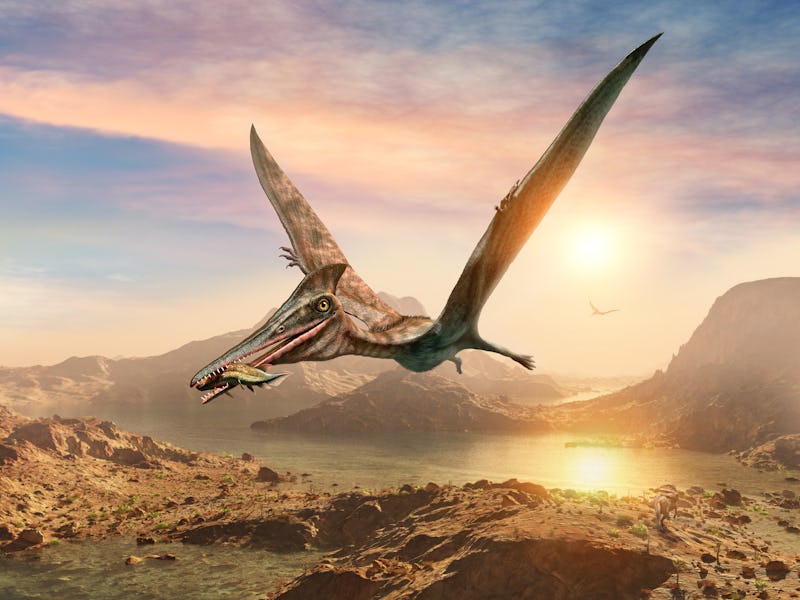What drones can learn from ancient flying reptiles
They flew better than us, plain and simple.

When humanity has wanted to fly, it has stolen from the world’s foremost experts, birds. From Leonardo da Vinci to modern-day concept vehicles, biomimicry is an essential aspect of human flight. Now, in a new study in Trends in Ecology & Evolution published on Wednesday, scientists are looking for inspiration from the creatures that brought birds into existence: ancient winged reptiles that lived side by side with dinosaurs.
"Engineers generally don't look to paleontology when thinking about inspiration for flight."
It might sound obvious—large, flying pterodactyls, which were part of the taxonomic order Pterosauria, are some of the most iconic flying animals in history, a staple of childhood wonder ever since it was first named in 1809 by Georges Cuvier, considered the modern father of paleontology. But when studying how to best design drones or achieve aerial stability, says first author Liz Martin-Silverstone (@gimpasaura), a post-doctoral researcher and paleontologist at the University of Bristol, speaking in a press statement, Pterosauria has often gone ignored.
"There's a lot of really cool stuff in the fossil record that goes unexplored because engineers generally don't look to paleontology when thinking about inspiration for flight,” she says. “If we're only looking at modern animals for inspiration, we're really missing a large degree of the morphology out there and ignoring a lot of options that I think could be useful."
As Marti-Silverstone and her co-authors point out in the study, powered flight, in which an animal can fly through the forces created by its own body, is incredibly rare among vertebrates. In the entire history of animals with backbones, only three times have they evolved towards powered flight. “While there are numerous clades with members that engage in unpowered flight, powered flight has only evolved three times with vertebrae lineages, in the birds, bats, and extinct pterosaurs,” they write.
Such a rare commodity deserves exploration, especially from those looking to replicate it, they argue. And pterosaur fossils can become vivid teaching tools.
A drawing of a giant pterosaur.
"There are two or three absolutely amazingly preserved pterosaur fossils that let you see the different layers within the wing membrane, giving us insight into its fibrous components. Also, some fossils are preserved enough to show the wing attachments beneath the hip," Marti-Silverstone says. "While you don't know exactly the shape of the wing, by knowing the membrane attachments you can model the effectiveness of different wing shapes and determine which would have performed best in natural conditions."
They did what we're struggling with
Ancient flying reptiles mastered things that modern day fliers still find difficult. Larger, fixed-wing drones still require runways for takeoff, and vertical takeoff technology has to find its way into the mainstream. Even large birds need a running start. But ptreosaurs, which could weigh over 600 pounds, were able to become airborne where they stood.
How? Co-author Mike Habib (@aeroevo) of the Dinosaur Institute at the Natural History Museum of Los Angeles County, suspects that the answer lies in their ancient flying reptilian wing membranes. Broken into the three parts, the most forward-facing part of their wings are called propatagium, which connect to the pterosaur’s wrists. “Robust muscle attachments” would allow pterosaurs to generate a high-powered leap off of their elbows and wrists, Habib speculates.
"The unique launch physiology of pterosaurs might be able to help solve some of these problems."
"Today, something like a drone requires a flat surface to launch and is quite restricted on how it actually gets into the air. The unique launch physiology of pterosaurs might be able to help solve some of these problems," Martin-Silverstone says.
It’s not just their vertical takeoff that intrigues scientists. Once in the air, continued stability is the goal of any flier. Strong winds are a challenge for all sorts of vessels—think of the rippling of a sail on a sailboat. Contrary to that rippling effect, pterosaurs evolved to resist fluttering.
"So far we've struggled to design things like flight suits that can resist the pressures of flight. If we can understand how pterosaurs did it, for instance by understanding how their wing membrane was actually structured, then that's something we can use to answer modern engineering questions," Martin-Silverstone says.
For engineers, the question comes down to using all the possible tools in a toolbox. Birds, bats, and other machines offer a variety of helpful guides. But to build something different, why not start where nobody else is looking, the (very) distant past?
"We want biologists and engineers alike to reach out to paleontologists when they are looking to solving flight problems, as there might be something extinct that could help,” Martin-Silverstone says. “If we limit ourselves to looking at the modern animals, then we're missing out on a lot of diversity that might be useful."